Business and the Business Environment: Coca-Cola Case Study Report
VerifiedAdded on 2020/06/04
|22
|5937
|55
Report
AI Summary
This report examines the business environment, encompassing the analysis of different organizational structures, including public, private (with a focus on Coca-Cola), and voluntary sectors. It defines organizations, outlines their features, and provides examples. The report explores the size and scope of various organizations, differentiating between small, medium, and large enterprises. It also details the relationship between different organizational functions, using a chart to illustrate these connections and discusses Coca-Cola's structure, objectives, and the impacts of its structure, functions, and objectives. Furthermore, it assesses the positive and negative impacts of the macro environment on organizations. The report concludes with an internal and external analysis, identifying strengths and weaknesses and relating these to external factors.
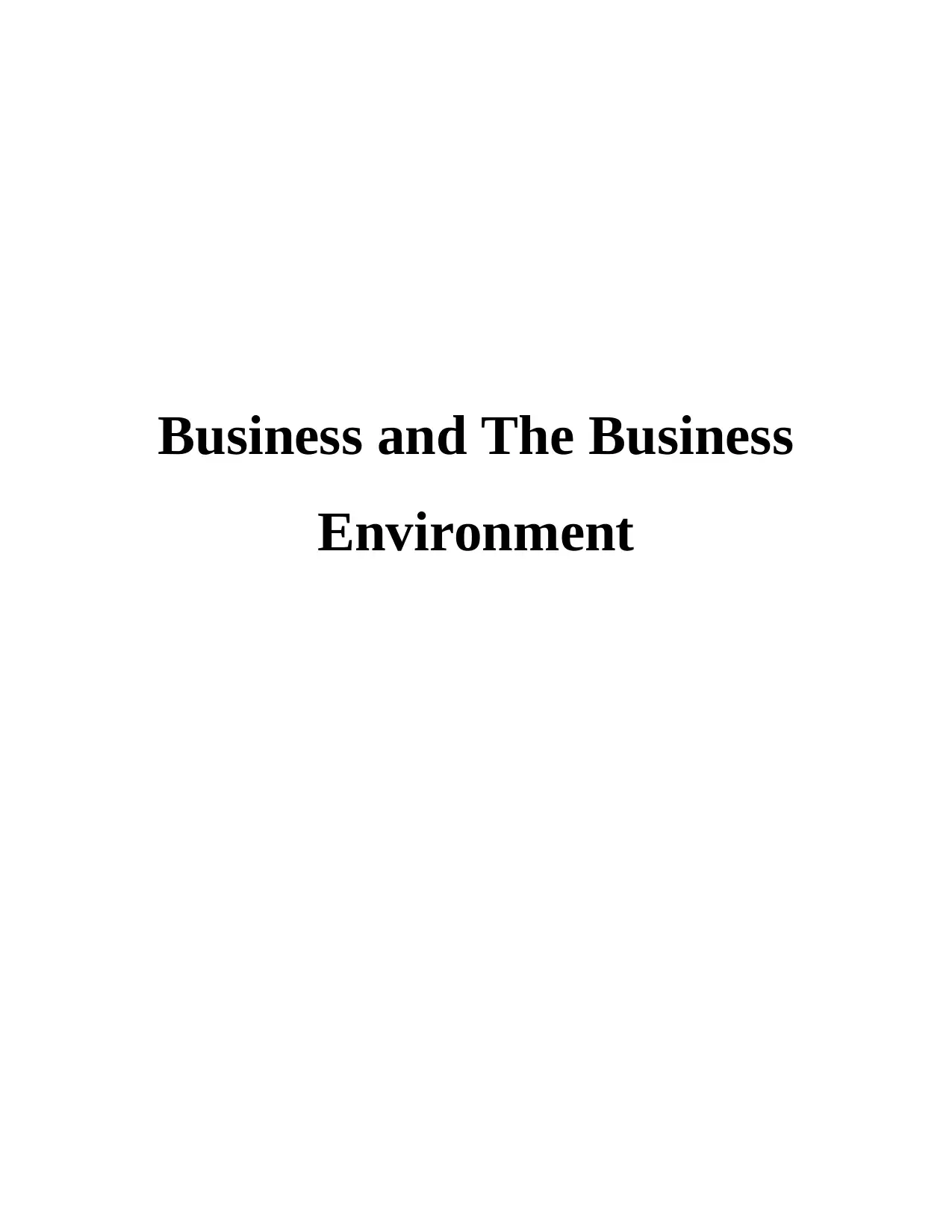
Business and The Business
Environment
Environment
Paraphrase This Document
Need a fresh take? Get an instant paraphrase of this document with our AI Paraphraser
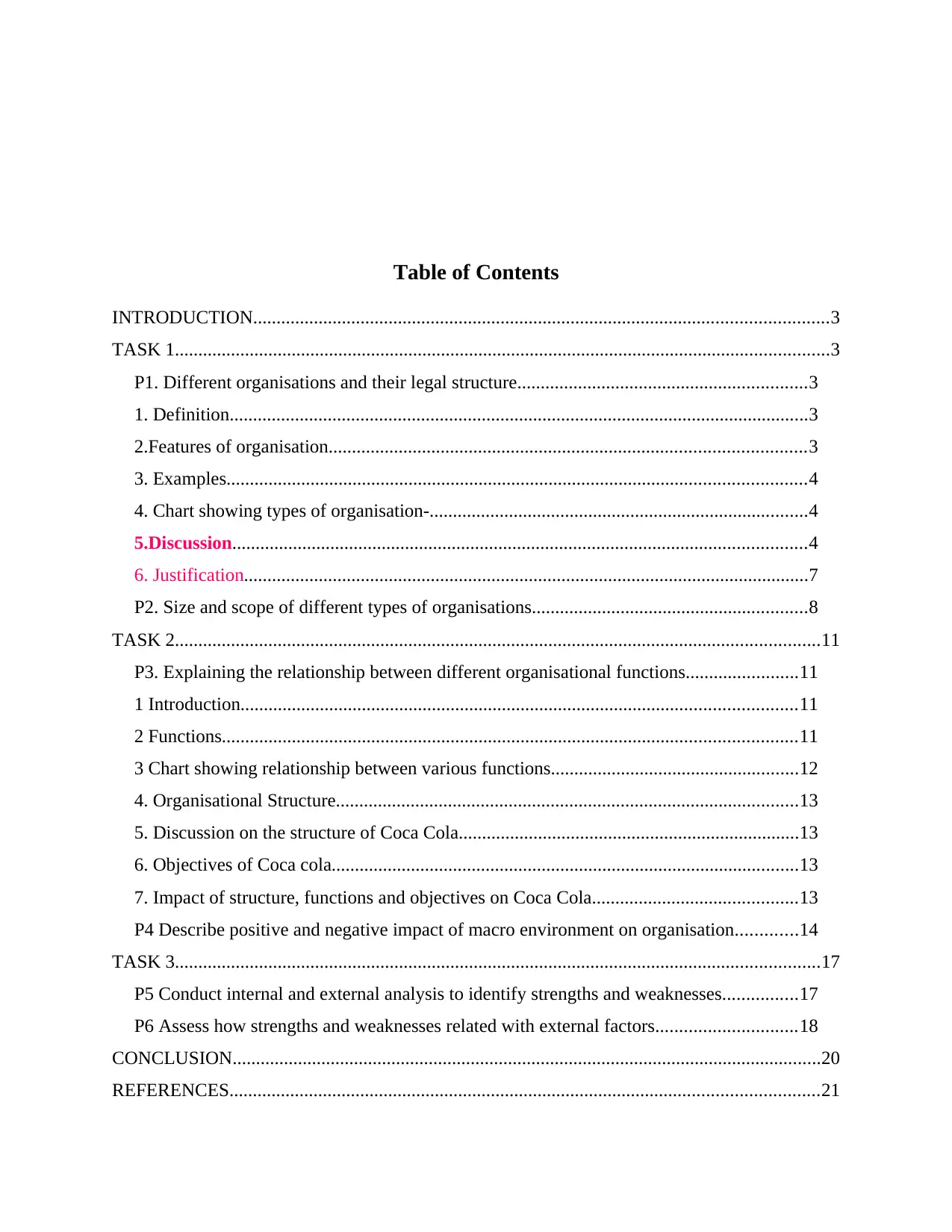
Table of Contents
INTRODUCTION...........................................................................................................................3
TASK 1............................................................................................................................................3
P1. Different organisations and their legal structure..............................................................3
1. Definition............................................................................................................................3
2.Features of organisation......................................................................................................3
3. Examples............................................................................................................................4
4. Chart showing types of organisation-.................................................................................4
5.Discussion...........................................................................................................................4
6. Justification.........................................................................................................................7
P2. Size and scope of different types of organisations...........................................................8
TASK 2..........................................................................................................................................11
P3. Explaining the relationship between different organisational functions........................11
1 Introduction.......................................................................................................................11
2 Functions...........................................................................................................................11
3 Chart showing relationship between various functions.....................................................12
4. Organisational Structure...................................................................................................13
5. Discussion on the structure of Coca Cola.........................................................................13
6. Objectives of Coca cola....................................................................................................13
7. Impact of structure, functions and objectives on Coca Cola............................................13
P4 Describe positive and negative impact of macro environment on organisation.............14
TASK 3..........................................................................................................................................17
P5 Conduct internal and external analysis to identify strengths and weaknesses................17
P6 Assess how strengths and weaknesses related with external factors..............................18
CONCLUSION..............................................................................................................................20
REFERENCES..............................................................................................................................21
INTRODUCTION...........................................................................................................................3
TASK 1............................................................................................................................................3
P1. Different organisations and their legal structure..............................................................3
1. Definition............................................................................................................................3
2.Features of organisation......................................................................................................3
3. Examples............................................................................................................................4
4. Chart showing types of organisation-.................................................................................4
5.Discussion...........................................................................................................................4
6. Justification.........................................................................................................................7
P2. Size and scope of different types of organisations...........................................................8
TASK 2..........................................................................................................................................11
P3. Explaining the relationship between different organisational functions........................11
1 Introduction.......................................................................................................................11
2 Functions...........................................................................................................................11
3 Chart showing relationship between various functions.....................................................12
4. Organisational Structure...................................................................................................13
5. Discussion on the structure of Coca Cola.........................................................................13
6. Objectives of Coca cola....................................................................................................13
7. Impact of structure, functions and objectives on Coca Cola............................................13
P4 Describe positive and negative impact of macro environment on organisation.............14
TASK 3..........................................................................................................................................17
P5 Conduct internal and external analysis to identify strengths and weaknesses................17
P6 Assess how strengths and weaknesses related with external factors..............................18
CONCLUSION..............................................................................................................................20
REFERENCES..............................................................................................................................21

INTRODUCTION
Business environment is a combination of external and internal factors that affect the
decisions of organisation. It includes micro and macro surroundings which are related with
business and these can be used to improve the efficiency and capability of company's operations.
Private, public and voluntary firms will be discussed here in the following report. Coca Cola has
been chosen as a private entity which is the world's largest beverage manufacturing
establishment and leading soft drink producer and marketer. Different internal and external
factors that affect the business operations will be discussed in this study. Positive and negative
impacts of such issues would be assessed as well.
TASK 1
P1. Different organisations and their legal structure
1. Definition
According to Louis Allen, “Organisation is the process of determining and grouping tasks
to be performed, delegating and defining authority and responsibility and form relationship to
motivate people in order to achieve organisational objectives effectively.” It is a broader term as
it consists business operations for commercial purpose. Organisations have particular structure
and various functional units. Employees and system forms a culture that directs its operations.
Different organisations have their own set of policies and guidelines.
2.Features of organisation
Essential features of organisation includes division of work, coordination, common
objectives, and plurality of people. Business organisation is a group of people that collaborates to
attain some common goals. Some organisations are established to earn profits whereas few are
formed as non-profit institutions. Some of the main features are following-
There is effective sharing of goals and objectives at various levels of organisation.
Another important characteristic is teamwork. People collaborates to attain common
objectives.
Organisations adopts opportunities and latest changes in order achieve growth.
There is clearly defined structure which performs various functions of business.
Business environment is a combination of external and internal factors that affect the
decisions of organisation. It includes micro and macro surroundings which are related with
business and these can be used to improve the efficiency and capability of company's operations.
Private, public and voluntary firms will be discussed here in the following report. Coca Cola has
been chosen as a private entity which is the world's largest beverage manufacturing
establishment and leading soft drink producer and marketer. Different internal and external
factors that affect the business operations will be discussed in this study. Positive and negative
impacts of such issues would be assessed as well.
TASK 1
P1. Different organisations and their legal structure
1. Definition
According to Louis Allen, “Organisation is the process of determining and grouping tasks
to be performed, delegating and defining authority and responsibility and form relationship to
motivate people in order to achieve organisational objectives effectively.” It is a broader term as
it consists business operations for commercial purpose. Organisations have particular structure
and various functional units. Employees and system forms a culture that directs its operations.
Different organisations have their own set of policies and guidelines.
2.Features of organisation
Essential features of organisation includes division of work, coordination, common
objectives, and plurality of people. Business organisation is a group of people that collaborates to
attain some common goals. Some organisations are established to earn profits whereas few are
formed as non-profit institutions. Some of the main features are following-
There is effective sharing of goals and objectives at various levels of organisation.
Another important characteristic is teamwork. People collaborates to attain common
objectives.
Organisations adopts opportunities and latest changes in order achieve growth.
There is clearly defined structure which performs various functions of business.
⊘ This is a preview!⊘
Do you want full access?
Subscribe today to unlock all pages.

Trusted by 1+ million students worldwide

3. Examples
There are number of organisations and some of its examples are, Coca Cola, NHS and
Oxfam. Organisations are involved in different types of business such as-
Service organisation provides intangible products like professional skills. Examples of
such business are schools, banks, salons etc.
Merchandising business includes buying and selling of goods. Example- Grocery stores.
Manufacturing business operates in production of products.
4. Chart showing types of organisation-
5.Discussion
(a)Public sector- NHS comes under this sector.
Definition- Such type of firms are not very much focussed towards profit making and these
entities are regulated by the government.
Purpose- Their main motive is to provide high quality products and services at low prices.Its
production decisions are usually taken by the legal authorities(Commander and Svejnar, 2011).
Such firms are mainly incorporated for the benefit of society by providing services like
education, healthcare, public transits, etc.
Legal structure- Its legal structures include rules and regulations made by central, state and
local government. It is required to comply all policies, laws and legalities issued by regulated
bodies. Such organisations includes services like military, infrastructure, electrical grids,
Illustration 1: Types of organisations, 2017
There are number of organisations and some of its examples are, Coca Cola, NHS and
Oxfam. Organisations are involved in different types of business such as-
Service organisation provides intangible products like professional skills. Examples of
such business are schools, banks, salons etc.
Merchandising business includes buying and selling of goods. Example- Grocery stores.
Manufacturing business operates in production of products.
4. Chart showing types of organisation-
5.Discussion
(a)Public sector- NHS comes under this sector.
Definition- Such type of firms are not very much focussed towards profit making and these
entities are regulated by the government.
Purpose- Their main motive is to provide high quality products and services at low prices.Its
production decisions are usually taken by the legal authorities(Commander and Svejnar, 2011).
Such firms are mainly incorporated for the benefit of society by providing services like
education, healthcare, public transits, etc.
Legal structure- Its legal structures include rules and regulations made by central, state and
local government. It is required to comply all policies, laws and legalities issued by regulated
bodies. Such organisations includes services like military, infrastructure, electrical grids,
Illustration 1: Types of organisations, 2017
Paraphrase This Document
Need a fresh take? Get an instant paraphrase of this document with our AI Paraphraser

telecommunications etc. Public sector's services are not just for an individual but for whole
society.
Illustration 2: Legal structure of public company
(b) Private sector- Coco Cola comes under this sector.
Definition- Such type of organisations is usually free from the control of government.
Purpose- These are more focussed towards profit making. This organisation provides
employment to most of the workforce in some countries. It is suitable for free economies like
UK and USA. Such entities are regulated by states and it has to follow laws of that country. It is
also referred as citizen sector as it is operated by private groups and individuals. Public sector
organisations provide services to everyone by private organisation deals with those who pays
them. Such firms are involved in fluctuations in pricing in order compete with competitors and
attract more consumers.
Legal structure- Its legal structure includes -
society.
Illustration 2: Legal structure of public company
(b) Private sector- Coco Cola comes under this sector.
Definition- Such type of organisations is usually free from the control of government.
Purpose- These are more focussed towards profit making. This organisation provides
employment to most of the workforce in some countries. It is suitable for free economies like
UK and USA. Such entities are regulated by states and it has to follow laws of that country. It is
also referred as citizen sector as it is operated by private groups and individuals. Public sector
organisations provide services to everyone by private organisation deals with those who pays
them. Such firms are involved in fluctuations in pricing in order compete with competitors and
attract more consumers.
Legal structure- Its legal structure includes -
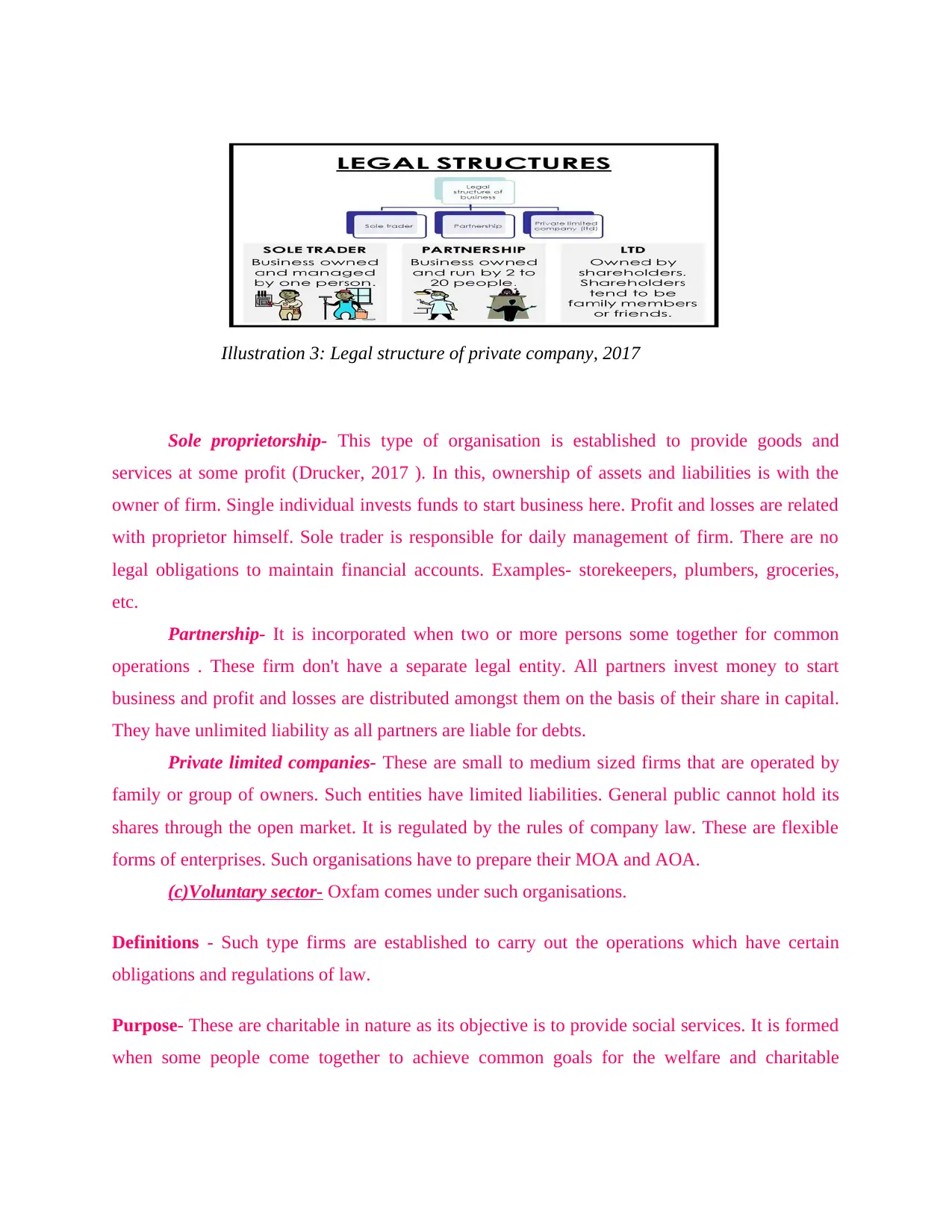
Sole proprietorship- This type of organisation is established to provide goods and
services at some profit (Drucker, 2017 ). In this, ownership of assets and liabilities is with the
owner of firm. Single individual invests funds to start business here. Profit and losses are related
with proprietor himself. Sole trader is responsible for daily management of firm. There are no
legal obligations to maintain financial accounts. Examples- storekeepers, plumbers, groceries,
etc.
Partnership- It is incorporated when two or more persons some together for common
operations . These firm don't have a separate legal entity. All partners invest money to start
business and profit and losses are distributed amongst them on the basis of their share in capital.
They have unlimited liability as all partners are liable for debts.
Private limited companies- These are small to medium sized firms that are operated by
family or group of owners. Such entities have limited liabilities. General public cannot hold its
shares through the open market. It is regulated by the rules of company law. These are flexible
forms of enterprises. Such organisations have to prepare their MOA and AOA.
(c)Voluntary sector- Oxfam comes under such organisations.
Definitions - Such type firms are established to carry out the operations which have certain
obligations and regulations of law.
Purpose- These are charitable in nature as its objective is to provide social services. It is formed
when some people come together to achieve common goals for the welfare and charitable
Illustration 3: Legal structure of private company, 2017
services at some profit (Drucker, 2017 ). In this, ownership of assets and liabilities is with the
owner of firm. Single individual invests funds to start business here. Profit and losses are related
with proprietor himself. Sole trader is responsible for daily management of firm. There are no
legal obligations to maintain financial accounts. Examples- storekeepers, plumbers, groceries,
etc.
Partnership- It is incorporated when two or more persons some together for common
operations . These firm don't have a separate legal entity. All partners invest money to start
business and profit and losses are distributed amongst them on the basis of their share in capital.
They have unlimited liability as all partners are liable for debts.
Private limited companies- These are small to medium sized firms that are operated by
family or group of owners. Such entities have limited liabilities. General public cannot hold its
shares through the open market. It is regulated by the rules of company law. These are flexible
forms of enterprises. Such organisations have to prepare their MOA and AOA.
(c)Voluntary sector- Oxfam comes under such organisations.
Definitions - Such type firms are established to carry out the operations which have certain
obligations and regulations of law.
Purpose- These are charitable in nature as its objective is to provide social services. It is formed
when some people come together to achieve common goals for the welfare and charitable
Illustration 3: Legal structure of private company, 2017
⊘ This is a preview!⊘
Do you want full access?
Subscribe today to unlock all pages.

Trusted by 1+ million students worldwide

purpose. This mainly includes NGOs, foundations and non-profit organisations. In this group of
individuals comes in a agreement as volunteers to complete various purpose.
Legal structure- Such organisations covers every group of small local residents. In UK,
England and Wales Act deals with legal issues of voluntary organisations.
6. Justification
From the above scenario, it can be seen that there are various types of organisation. All of
these have different aims, objectives and legal structures. Some are established to earn profits
whereas some focusses at providing social welfare services. Every member of organisation
works towards achieving ultimate goals of company collectively. Few organisations has higher
control of government bodies but some operates independently. Coca cola is an Private Ltd
company. This focusses more on profit maximization through its various functional units. Its
objective is to maintain transparency in annual reports and other financial statements. They have
appropriate organisational structure for their different businesses. They are involved intense
competition with their competitive strategies and marketing plans.
Illustration 4: legal structure of voluntary company, 2017
individuals comes in a agreement as volunteers to complete various purpose.
Legal structure- Such organisations covers every group of small local residents. In UK,
England and Wales Act deals with legal issues of voluntary organisations.
6. Justification
From the above scenario, it can be seen that there are various types of organisation. All of
these have different aims, objectives and legal structures. Some are established to earn profits
whereas some focusses at providing social welfare services. Every member of organisation
works towards achieving ultimate goals of company collectively. Few organisations has higher
control of government bodies but some operates independently. Coca cola is an Private Ltd
company. This focusses more on profit maximization through its various functional units. Its
objective is to maintain transparency in annual reports and other financial statements. They have
appropriate organisational structure for their different businesses. They are involved intense
competition with their competitive strategies and marketing plans.
Illustration 4: legal structure of voluntary company, 2017
Paraphrase This Document
Need a fresh take? Get an instant paraphrase of this document with our AI Paraphraser
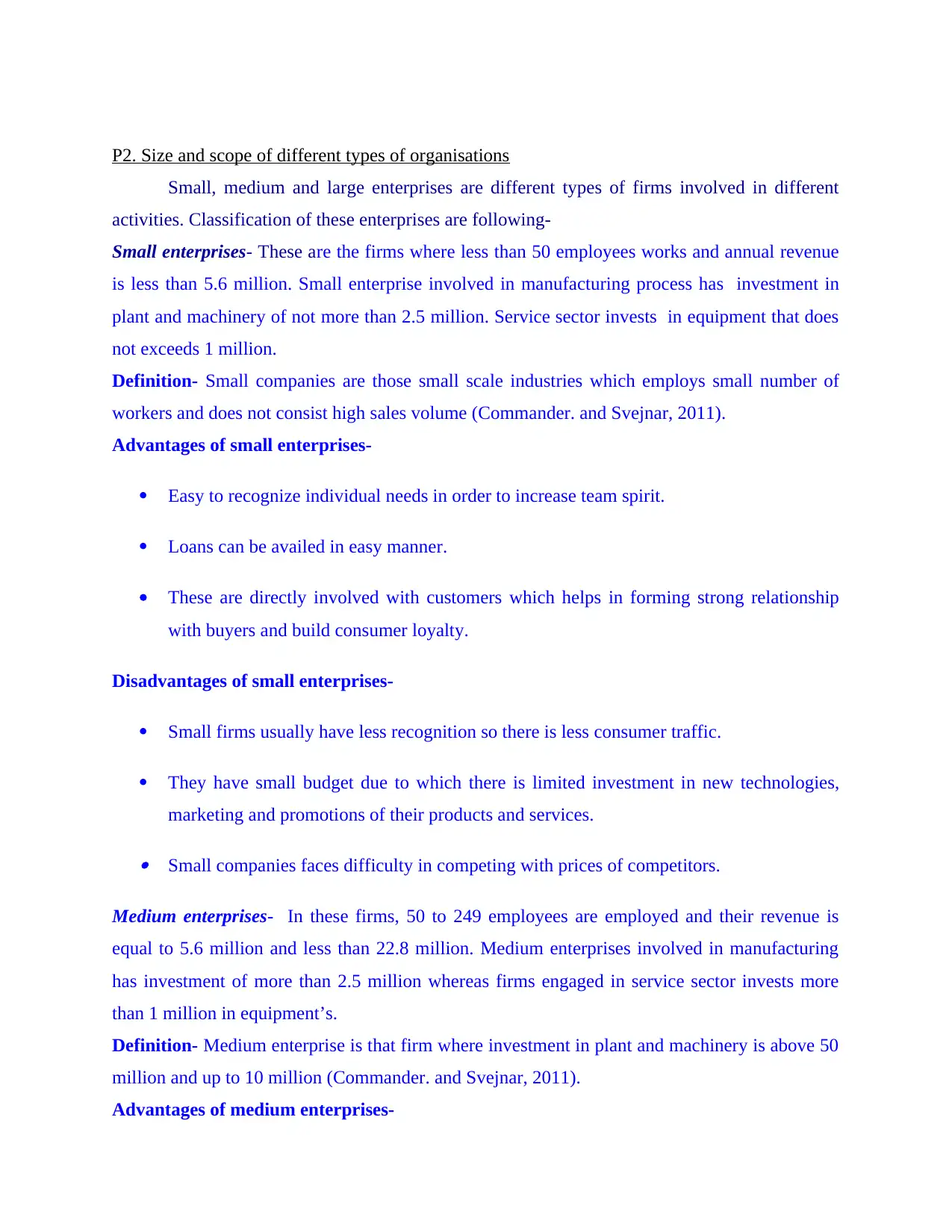
P2. Size and scope of different types of organisations
Small, medium and large enterprises are different types of firms involved in different
activities. Classification of these enterprises are following-
Small enterprises- These are the firms where less than 50 employees works and annual revenue
is less than 5.6 million. Small enterprise involved in manufacturing process has investment in
plant and machinery of not more than 2.5 million. Service sector invests in equipment that does
not exceeds 1 million.
Definition- Small companies are those small scale industries which employs small number of
workers and does not consist high sales volume (Commander. and Svejnar, 2011).
Advantages of small enterprises-
Easy to recognize individual needs in order to increase team spirit.
Loans can be availed in easy manner.
These are directly involved with customers which helps in forming strong relationship
with buyers and build consumer loyalty.
Disadvantages of small enterprises-
Small firms usually have less recognition so there is less consumer traffic.
They have small budget due to which there is limited investment in new technologies,
marketing and promotions of their products and services.
Small companies faces difficulty in competing with prices of competitors.
Medium enterprises- In these firms, 50 to 249 employees are employed and their revenue is
equal to 5.6 million and less than 22.8 million. Medium enterprises involved in manufacturing
has investment of more than 2.5 million whereas firms engaged in service sector invests more
than 1 million in equipment’s.
Definition- Medium enterprise is that firm where investment in plant and machinery is above 50
million and up to 10 million (Commander. and Svejnar, 2011).
Advantages of medium enterprises-
Small, medium and large enterprises are different types of firms involved in different
activities. Classification of these enterprises are following-
Small enterprises- These are the firms where less than 50 employees works and annual revenue
is less than 5.6 million. Small enterprise involved in manufacturing process has investment in
plant and machinery of not more than 2.5 million. Service sector invests in equipment that does
not exceeds 1 million.
Definition- Small companies are those small scale industries which employs small number of
workers and does not consist high sales volume (Commander. and Svejnar, 2011).
Advantages of small enterprises-
Easy to recognize individual needs in order to increase team spirit.
Loans can be availed in easy manner.
These are directly involved with customers which helps in forming strong relationship
with buyers and build consumer loyalty.
Disadvantages of small enterprises-
Small firms usually have less recognition so there is less consumer traffic.
They have small budget due to which there is limited investment in new technologies,
marketing and promotions of their products and services.
Small companies faces difficulty in competing with prices of competitors.
Medium enterprises- In these firms, 50 to 249 employees are employed and their revenue is
equal to 5.6 million and less than 22.8 million. Medium enterprises involved in manufacturing
has investment of more than 2.5 million whereas firms engaged in service sector invests more
than 1 million in equipment’s.
Definition- Medium enterprise is that firm where investment in plant and machinery is above 50
million and up to 10 million (Commander. and Svejnar, 2011).
Advantages of medium enterprises-
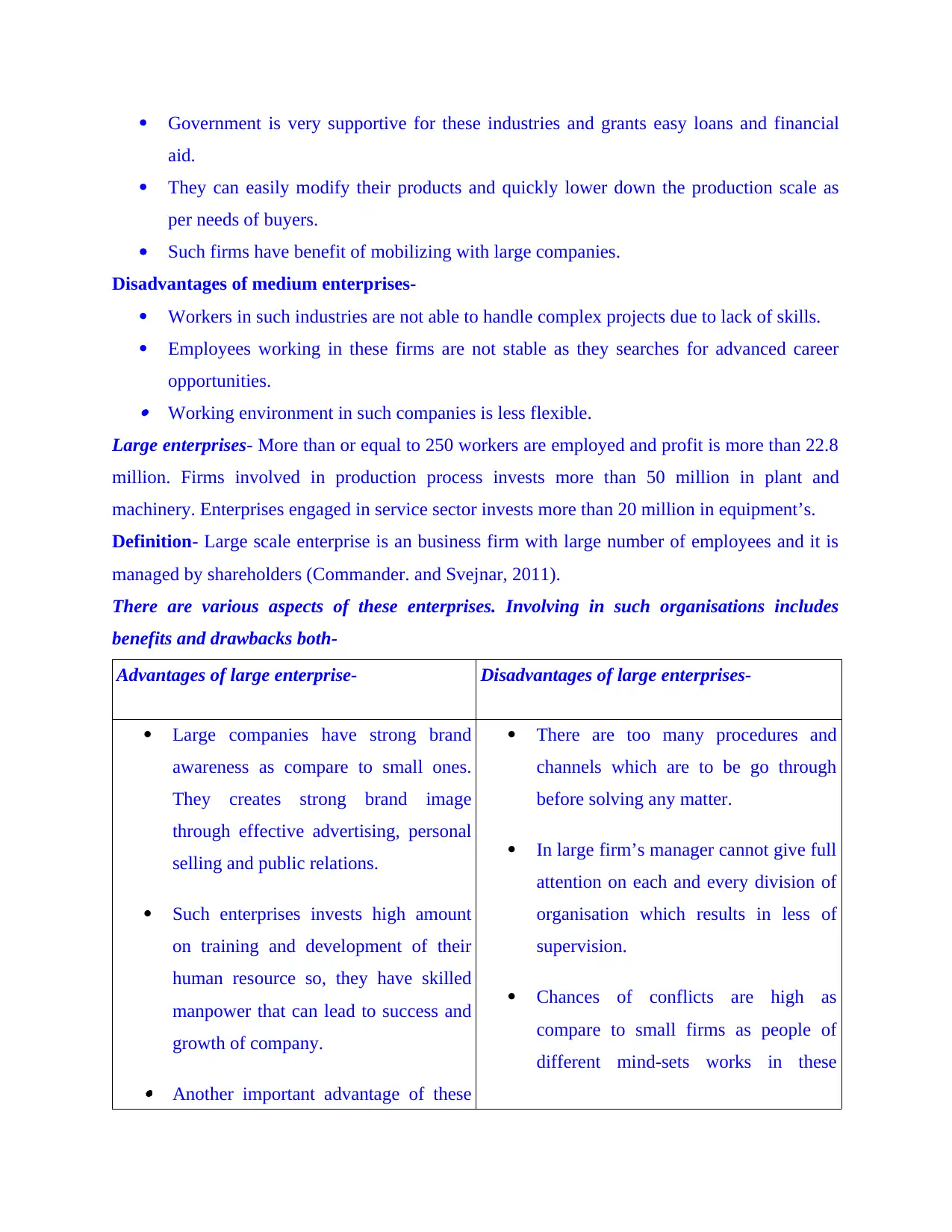
Government is very supportive for these industries and grants easy loans and financial
aid.
They can easily modify their products and quickly lower down the production scale as
per needs of buyers.
Such firms have benefit of mobilizing with large companies.
Disadvantages of medium enterprises-
Workers in such industries are not able to handle complex projects due to lack of skills.
Employees working in these firms are not stable as they searches for advanced career
opportunities. Working environment in such companies is less flexible.
Large enterprises- More than or equal to 250 workers are employed and profit is more than 22.8
million. Firms involved in production process invests more than 50 million in plant and
machinery. Enterprises engaged in service sector invests more than 20 million in equipment’s.
Definition- Large scale enterprise is an business firm with large number of employees and it is
managed by shareholders (Commander. and Svejnar, 2011).
There are various aspects of these enterprises. Involving in such organisations includes
benefits and drawbacks both-
Advantages of large enterprise- Disadvantages of large enterprises-
Large companies have strong brand
awareness as compare to small ones.
They creates strong brand image
through effective advertising, personal
selling and public relations.
Such enterprises invests high amount
on training and development of their
human resource so, they have skilled
manpower that can lead to success and
growth of company.
Another important advantage of these
There are too many procedures and
channels which are to be go through
before solving any matter.
In large firm’s manager cannot give full
attention on each and every division of
organisation which results in less of
supervision.
Chances of conflicts are high as
compare to small firms as people of
different mind-sets works in these
aid.
They can easily modify their products and quickly lower down the production scale as
per needs of buyers.
Such firms have benefit of mobilizing with large companies.
Disadvantages of medium enterprises-
Workers in such industries are not able to handle complex projects due to lack of skills.
Employees working in these firms are not stable as they searches for advanced career
opportunities. Working environment in such companies is less flexible.
Large enterprises- More than or equal to 250 workers are employed and profit is more than 22.8
million. Firms involved in production process invests more than 50 million in plant and
machinery. Enterprises engaged in service sector invests more than 20 million in equipment’s.
Definition- Large scale enterprise is an business firm with large number of employees and it is
managed by shareholders (Commander. and Svejnar, 2011).
There are various aspects of these enterprises. Involving in such organisations includes
benefits and drawbacks both-
Advantages of large enterprise- Disadvantages of large enterprises-
Large companies have strong brand
awareness as compare to small ones.
They creates strong brand image
through effective advertising, personal
selling and public relations.
Such enterprises invests high amount
on training and development of their
human resource so, they have skilled
manpower that can lead to success and
growth of company.
Another important advantage of these
There are too many procedures and
channels which are to be go through
before solving any matter.
In large firm’s manager cannot give full
attention on each and every division of
organisation which results in less of
supervision.
Chances of conflicts are high as
compare to small firms as people of
different mind-sets works in these
⊘ This is a preview!⊘
Do you want full access?
Subscribe today to unlock all pages.

Trusted by 1+ million students worldwide
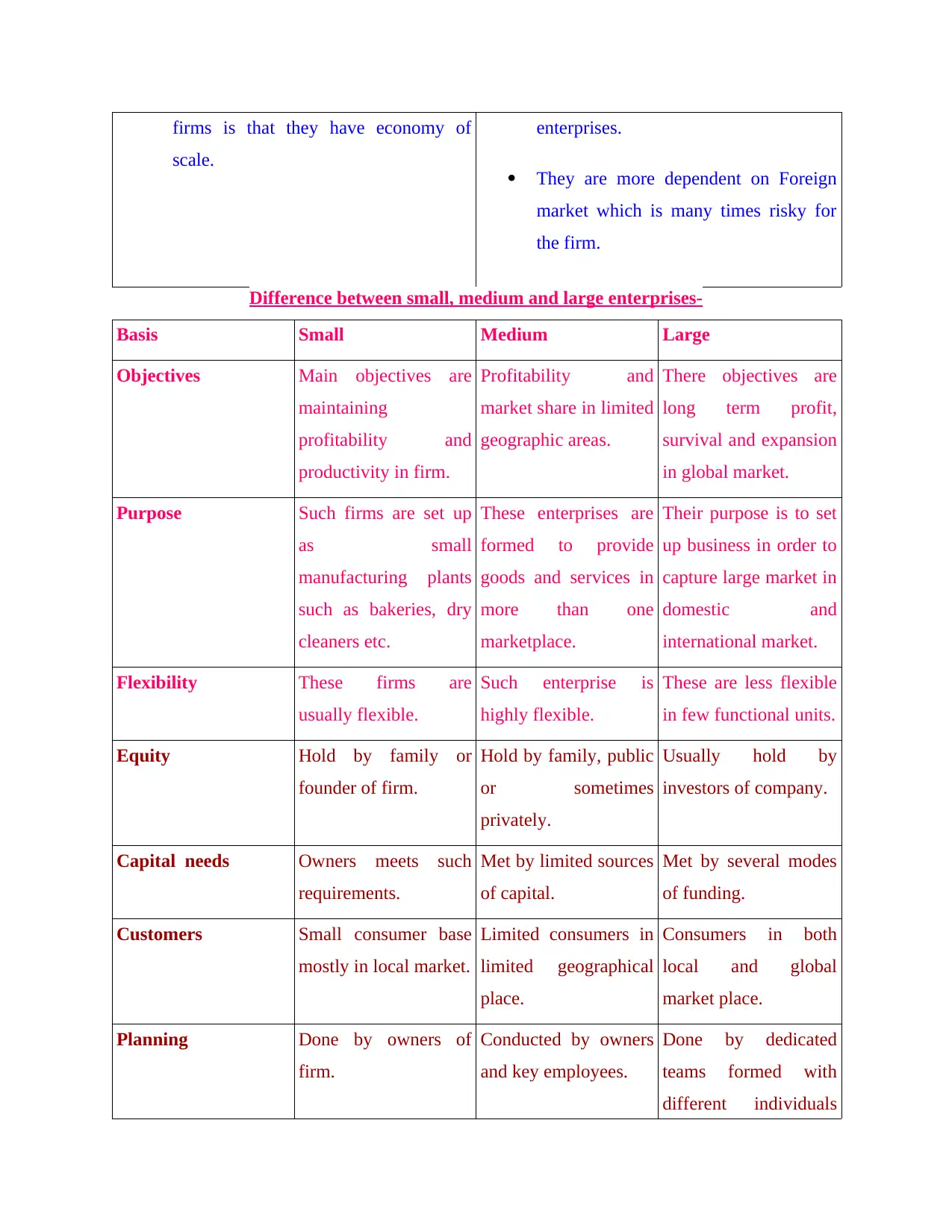
firms is that they have economy of
scale.
enterprises.
They are more dependent on Foreign
market which is many times risky for
the firm.
Difference between small, medium and large enterprises-
Basis Small Medium Large
Objectives Main objectives are
maintaining
profitability and
productivity in firm.
Profitability and
market share in limited
geographic areas.
There objectives are
long term profit,
survival and expansion
in global market.
Purpose Such firms are set up
as small
manufacturing plants
such as bakeries, dry
cleaners etc.
These enterprises are
formed to provide
goods and services in
more than one
marketplace.
Their purpose is to set
up business in order to
capture large market in
domestic and
international market.
Flexibility These firms are
usually flexible.
Such enterprise is
highly flexible.
These are less flexible
in few functional units.
Equity Hold by family or
founder of firm.
Hold by family, public
or sometimes
privately.
Usually hold by
investors of company.
Capital needs Owners meets such
requirements.
Met by limited sources
of capital.
Met by several modes
of funding.
Customers Small consumer base
mostly in local market.
Limited consumers in
limited geographical
place.
Consumers in both
local and global
market place.
Planning Done by owners of
firm.
Conducted by owners
and key employees.
Done by dedicated
teams formed with
different individuals
scale.
enterprises.
They are more dependent on Foreign
market which is many times risky for
the firm.
Difference between small, medium and large enterprises-
Basis Small Medium Large
Objectives Main objectives are
maintaining
profitability and
productivity in firm.
Profitability and
market share in limited
geographic areas.
There objectives are
long term profit,
survival and expansion
in global market.
Purpose Such firms are set up
as small
manufacturing plants
such as bakeries, dry
cleaners etc.
These enterprises are
formed to provide
goods and services in
more than one
marketplace.
Their purpose is to set
up business in order to
capture large market in
domestic and
international market.
Flexibility These firms are
usually flexible.
Such enterprise is
highly flexible.
These are less flexible
in few functional units.
Equity Hold by family or
founder of firm.
Hold by family, public
or sometimes
privately.
Usually hold by
investors of company.
Capital needs Owners meets such
requirements.
Met by limited sources
of capital.
Met by several modes
of funding.
Customers Small consumer base
mostly in local market.
Limited consumers in
limited geographical
place.
Consumers in both
local and global
market place.
Planning Done by owners of
firm.
Conducted by owners
and key employees.
Done by dedicated
teams formed with
different individuals
Paraphrase This Document
Need a fresh take? Get an instant paraphrase of this document with our AI Paraphraser
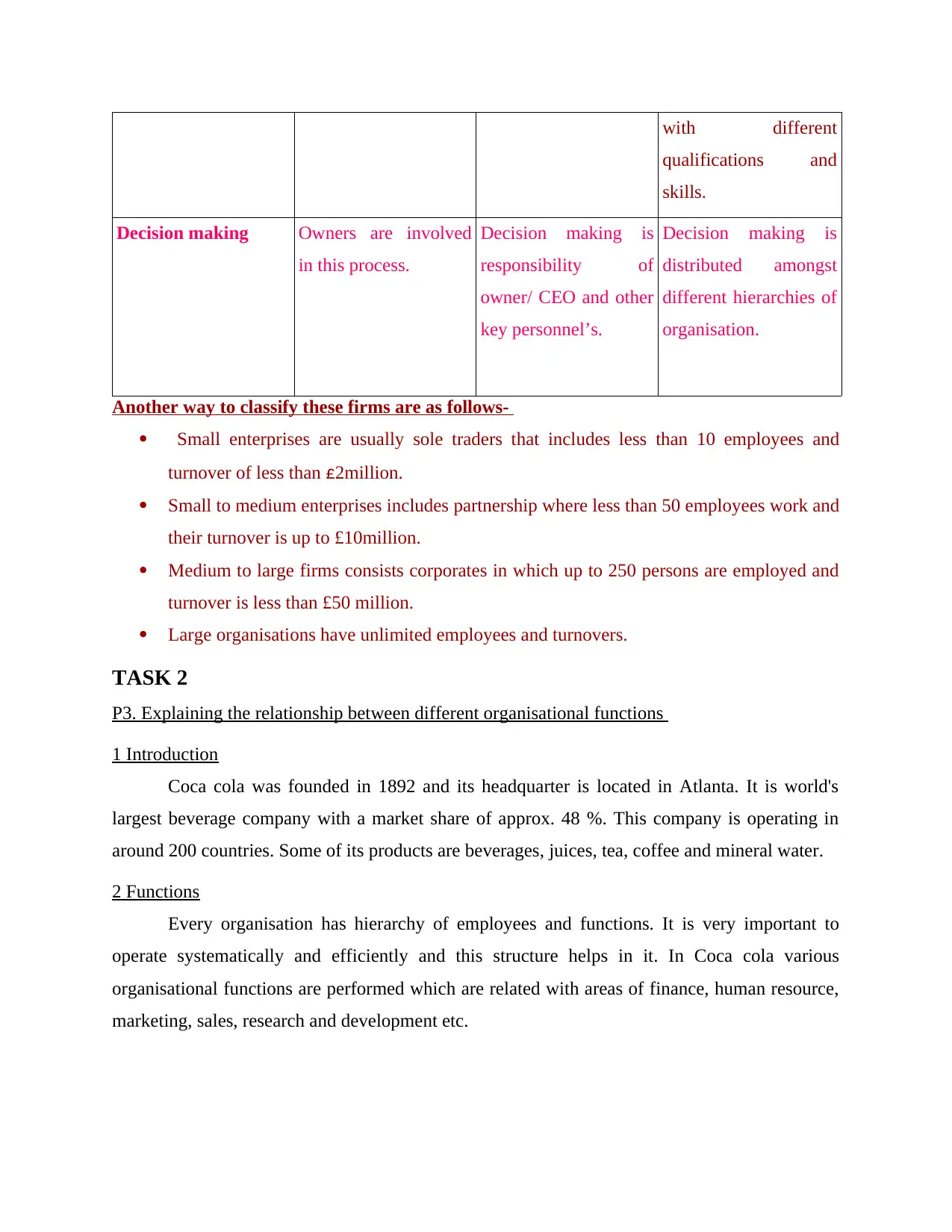
with different
qualifications and
skills.
Decision making Owners are involved
in this process.
Decision making is
responsibility of
owner/ CEO and other
key personnel’s.
Decision making is
distributed amongst
different hierarchies of
organisation.
Another way to classify these firms are as follows-
Small enterprises are usually sole traders that includes less than 10 employees and
turnover of less than £2million.
Small to medium enterprises includes partnership where less than 50 employees work and
their turnover is up to £10million.
Medium to large firms consists corporates in which up to 250 persons are employed and
turnover is less than £50 million.
Large organisations have unlimited employees and turnovers.
TASK 2
P3. Explaining the relationship between different organisational functions
1 Introduction
Coca cola was founded in 1892 and its headquarter is located in Atlanta. It is world's
largest beverage company with a market share of approx. 48 %. This company is operating in
around 200 countries. Some of its products are beverages, juices, tea, coffee and mineral water.
2 Functions
Every organisation has hierarchy of employees and functions. It is very important to
operate systematically and efficiently and this structure helps in it. In Coca cola various
organisational functions are performed which are related with areas of finance, human resource,
marketing, sales, research and development etc.
qualifications and
skills.
Decision making Owners are involved
in this process.
Decision making is
responsibility of
owner/ CEO and other
key personnel’s.
Decision making is
distributed amongst
different hierarchies of
organisation.
Another way to classify these firms are as follows-
Small enterprises are usually sole traders that includes less than 10 employees and
turnover of less than £2million.
Small to medium enterprises includes partnership where less than 50 employees work and
their turnover is up to £10million.
Medium to large firms consists corporates in which up to 250 persons are employed and
turnover is less than £50 million.
Large organisations have unlimited employees and turnovers.
TASK 2
P3. Explaining the relationship between different organisational functions
1 Introduction
Coca cola was founded in 1892 and its headquarter is located in Atlanta. It is world's
largest beverage company with a market share of approx. 48 %. This company is operating in
around 200 countries. Some of its products are beverages, juices, tea, coffee and mineral water.
2 Functions
Every organisation has hierarchy of employees and functions. It is very important to
operate systematically and efficiently and this structure helps in it. In Coca cola various
organisational functions are performed which are related with areas of finance, human resource,
marketing, sales, research and development etc.
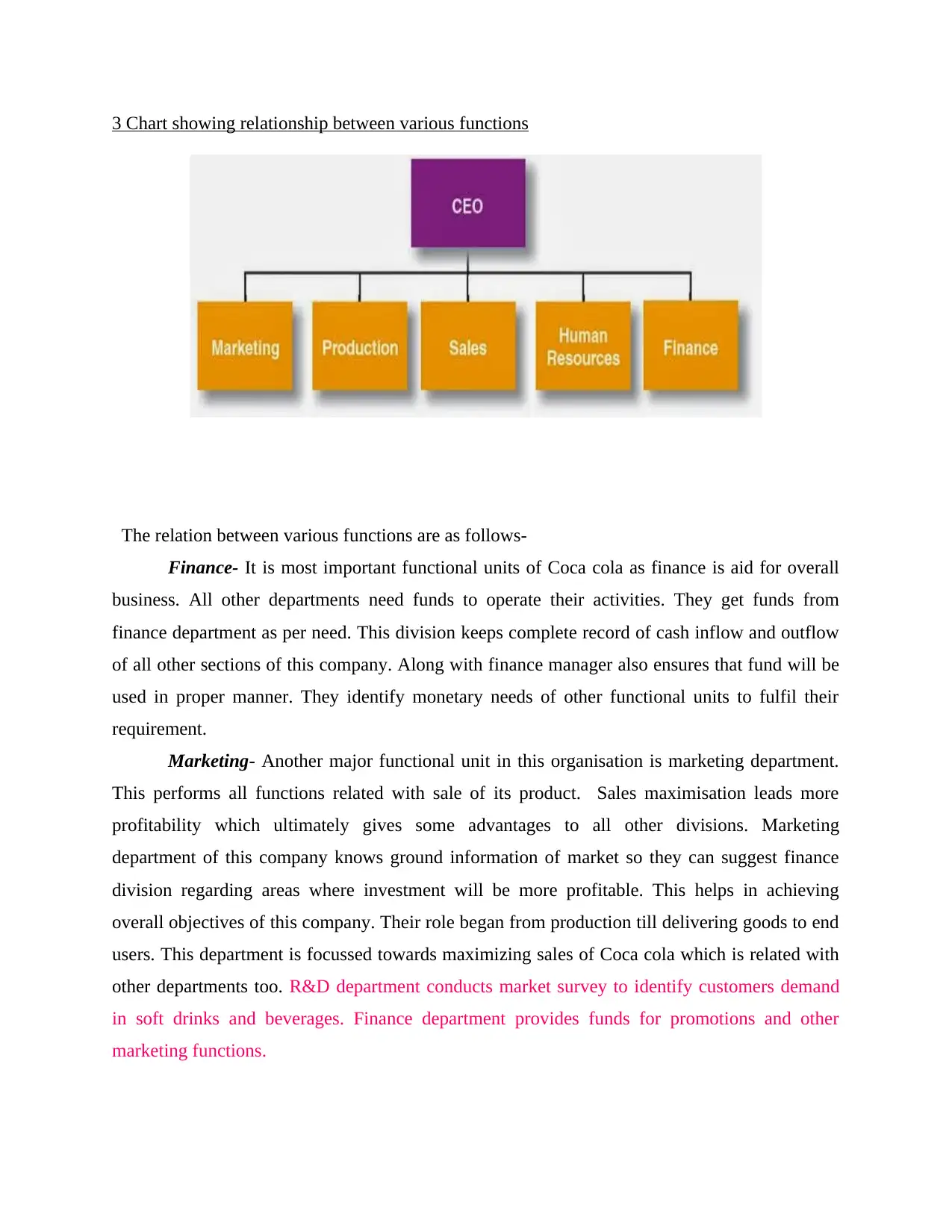
3 Chart showing relationship between various functions
The relation between various functions are as follows-
Finance- It is most important functional units of Coca cola as finance is aid for overall
business. All other departments need funds to operate their activities. They get funds from
finance department as per need. This division keeps complete record of cash inflow and outflow
of all other sections of this company. Along with finance manager also ensures that fund will be
used in proper manner. They identify monetary needs of other functional units to fulfil their
requirement.
Marketing- Another major functional unit in this organisation is marketing department.
This performs all functions related with sale of its product. Sales maximisation leads more
profitability which ultimately gives some advantages to all other divisions. Marketing
department of this company knows ground information of market so they can suggest finance
division regarding areas where investment will be more profitable. This helps in achieving
overall objectives of this company. Their role began from production till delivering goods to end
users. This department is focussed towards maximizing sales of Coca cola which is related with
other departments too. R&D department conducts market survey to identify customers demand
in soft drinks and beverages. Finance department provides funds for promotions and other
marketing functions.
The relation between various functions are as follows-
Finance- It is most important functional units of Coca cola as finance is aid for overall
business. All other departments need funds to operate their activities. They get funds from
finance department as per need. This division keeps complete record of cash inflow and outflow
of all other sections of this company. Along with finance manager also ensures that fund will be
used in proper manner. They identify monetary needs of other functional units to fulfil their
requirement.
Marketing- Another major functional unit in this organisation is marketing department.
This performs all functions related with sale of its product. Sales maximisation leads more
profitability which ultimately gives some advantages to all other divisions. Marketing
department of this company knows ground information of market so they can suggest finance
division regarding areas where investment will be more profitable. This helps in achieving
overall objectives of this company. Their role began from production till delivering goods to end
users. This department is focussed towards maximizing sales of Coca cola which is related with
other departments too. R&D department conducts market survey to identify customers demand
in soft drinks and beverages. Finance department provides funds for promotions and other
marketing functions.
⊘ This is a preview!⊘
Do you want full access?
Subscribe today to unlock all pages.

Trusted by 1+ million students worldwide
1 out of 22
Related Documents
Your All-in-One AI-Powered Toolkit for Academic Success.
+13062052269
info@desklib.com
Available 24*7 on WhatsApp / Email
![[object Object]](/_next/static/media/star-bottom.7253800d.svg)
Unlock your academic potential
Copyright © 2020–2025 A2Z Services. All Rights Reserved. Developed and managed by ZUCOL.





